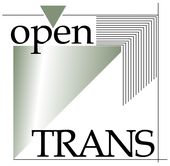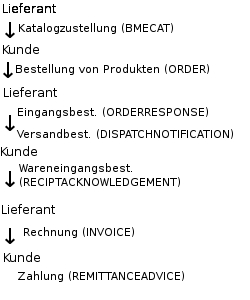openTRANS
openTRANS is an open standard to support electronic data interchange (EDI) in business transactions between trading companies . In doing so, it supports electronic procurement . It is integrated into the XML and XML schema- based standards. openTRANS is therefore similar to the EDIFACT standards, which are used to exchange business transactions electronically.
The standard was founded in an initiative by industrial and trading companies under the direction of Fraunhofer IAO in cooperation with the University of Duisburg-Essen (Department of Procurement, Logistics and Information Management, BLI) with the aim of standardizing business process documents (e.g. shipping notifications , Invoice ) as the basis for electronic system-to-system communication. Version 2.1 has been available since October 2, 2009.
History of the standard
The initiative of Fraunhofer IAO and the University of Duisburg-Essen BLI originally started with the publication of the catalog standard BMEcat in 1999. In addition to this XML-based standard, openTRANS was published two years later as an XML-based standard for business documents. Here, too, both organizations have taken the lead.
This close relationship has also remained an important feature in the new versions of the standards with BMEcat 2005 and openTRANS 2. This ensures compatibility in the elements that are used in both standards. In the following years, openTRANS was widely used in Germany, which did not change immediately with the English translation of the specifications . For the current version, the authors are committed to better international support. At the moment, however, it is still difficult to assess how widely the standard will be used.
The openTRANS releases are arranged chronologically as follows:
- 1.0 draft September 7, 2001
- 1.0 final January 10, 2003
- 2.0 draft August 28, 2008
- 2.0 final October 27, 2008
- 2.1 final draft July 1, 2009
- 2.1 final October 2, 2009 (current version)
- 3.0 draft April 18, 2012
Business documents in openTRANS 2
openTRANS 2 is an XML-based standard for the exchange of business documents. This exchange of business documents is known as a transaction. This makes openTRANS a transaction standard for the electronic support of business transactions. In contrast, there is, for example, BMEcat 2005 a standard for the electronic exchange of product catalogs within the scope of catalog management .
The following business documents are specified in the openTRANS 2 standard:
- RFQ (Request For Quotation, Request Quote )
- QUOTATION ( offer )
- ORDER (order or purchase order )
- ORDERCHANGE (order change)
- ORDERRESPONSE ( order confirmation )
- DISPATCHNOTIFICATION (shipping notification)
- RECEIPTACKNOWLEDGEMENT ( goods receipt confirmation )
- INVOICE (invoice)
- INVOICELIST (invoice list)
- REMITTANCEADVICE ( payment advice )
An example process using standards
A possible example of the exchange of certain business documents and information could be as follows:
openTRANS structure
In openTRANS 2 documents there are certain areas - header area, item area, summary.
- Header area (e.g. INVOICE_HEADER)
- All information related to the entire business document is described in the header area, e.g. B. on the creator and addressee of the document, as well as general framework conditions. The header area is structured similarly for all documents.
- Item area (e.g. INVOICE_ITEM_LIST)
- The position area represents the list area of a business document, e.g. For example, the products in a quotation, the delivery items in a shipping notification, or the invoices in an invoice list.
- Summary (e.g. INVOICE_SUMMARY)
- The "Summary" area concludes every business document. It contains redundant information that can be calculated from the aggregation of the values of the position lines and is only used for control purposes. In some business documents, such as the invoice, this area is required by law.
Extensions in openTRANS 2
In addition to numerous detailed improvements to the data models and the revision of the specification, additional general requirements have been implemented in openTRANS 2. The most important enhancements include:
- Revision of the invoice for conformity in the area of VAT legislation
- Support of processes for handling electronic signatures
- Expansion of the price models, in particular multi-level surcharges and discounts (discounts) and taxes
- Better support for scenarios with intermediaries, e.g. B. marketplaces or central regulators
- Expansion of the product model to map features and product components as well as configuration results and a new structure for packaging
- Two new business documents: payment advice note and collective invoice or invoice list
- Most extensive compatibility with BMEcat 2005, e.g. B. Renaming of the elements from ARTICLE to PRODUCT
Downward compatibility with openTRANS 1
openTRANS 2 is not downwardly compatible with openTRANS 1, but has a very similar structure. Most of the elements from openTRANS 1 were reused and only added new sub-elements.
Compatibility with BMEcat
openTRANS-2 business documents are compatible with BMEcat-2005 catalog documents, which means that identical fields and structures with identical meanings and rules are used. This correspondence facilitates the uniform use of data and software systems. Due to the asynchronous development cycles of the two standards, in a few exceptional cases elements and element structures in openTRANS 2 differ from those in BMEcat 2005 (e.g. PARTY).

